dady172172
New member
- Joined
- Feb 2, 2014
- Messages
- 2
Thank you i have no idea what this problem is.
By doubling each dimension, the area of a parallelogram increased from 36 square centimeters to 144 square centimeters. Find the percent increase in area.. The answer is 300% (i cheated and looked in the back of the book) but no matter what i try i can't get 300% for some reason. Its bothering me i can't do this problem.. I want to learn how to do it.
By doubling each dimension, the area of a parallelogram increased from 36 square centimeters to 144 square centimeters. Find the percent increase in area.. The answer is 300% (i cheated and looked in the back of the book) but no matter what i try i can't get 300% for some reason. Its bothering me i can't do this problem.. I want to learn how to do it.
Attachments
Last edited:

